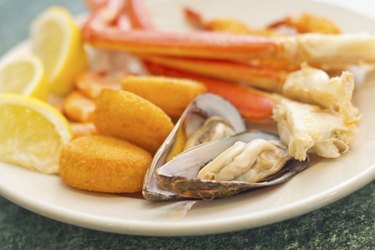
Seafood allergies include any allergic reaction to foods from salt or fresh water. This includes shelled and finned fish; crab, oysters, shrimp, trout and salmon. If you are allergic to seafood, you should not consume or come into contact with any seafood product. A common symptom that develops after eating seafood, if you're allergic, is stomach cramps. Other gastric symptoms will accompany the cramping and can lead to vomiting and diarrhea in severe cases. Discuss your symptoms with your doctor before attempting to treat them yourself.
Seafood Allergy
Video of the Day
A seafood allergy is commonly considered a life-long allergic condition that is incurable. Almost 2.5 million of Americans are diagnosed with a seafood allergy, according to Food Allergy Research & Education, or FARE. The Allergy and Asthma Foundation of America states that seafood allergies are commonly associated with anaphylactic shock, an extreme allergic reaction that could lead to death. If you're allergic to one type of fish you have a 50 percent chance of having an allergy to other types of fish. Cross-contamination is a concern if you have a fish allergy because fish are typically handled together.
Video of the Day
Cause
Stomach cramps are caused by the presence of histamine in the intestines. When you experience an allergic reaction, your body creates various chemicals to fight off the proteins from the seafood. Histamine and immunoglobulin E, or IgE, antibodies are the two chemicals that primarily cause allergic reaction symptoms. The proteins in the seafood are identified by your body as harmful, when in reality they are safe. Increased levels of histamine in the digestive tract cause inflammation to develop in the gut, which causes stomach cramping and pain.
Other Symptoms
Stomach cramps will not be the only symptom resulting from a seafood allergy. If you only experience cramping without any other symptoms, you may have an intolerance towards certain seafood. Other symptoms that may develop include hives, tingling in the mouth, lips or throat, facial swelling, skin rashes, general itching, nausea, vomiting, diarrhea, wheezing, difficulty breathing, coughing and nasal congestion.
Treatment
The most effective treatment for a seafood allergy is to avoid seafood altogether. Food manufacturers are required by law to state if a pre-packaged food contains fish or seafood, or is processed in a facility that may contaminate certain food items. Read all product labels before eating anything and ask your server when eating out about allergens in the entrees. If you accidentally eat seafood, there's nothing you can do to treat stomach cramps, aside from drinking plenty of water, lying down and waiting for your body to eliminate the seafood proteins.
Is this an emergency? If you are experiencing serious medical symptoms, please see the National Library of Medicine’s list of signs you need emergency medical attention or call 911.